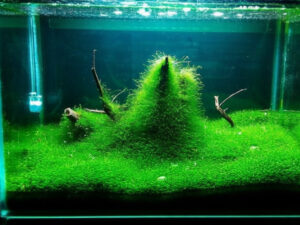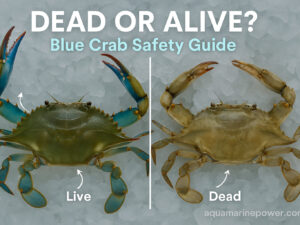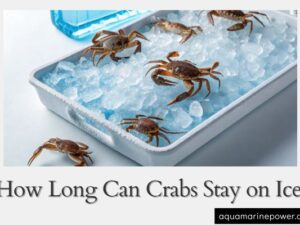Nothing ruins a crab feast faster than cracking open expensive crabs only to find them hollow and meatless. Whether you're buying from a seafood market or catching your own, knowing how to identify meaty crabs can save you money and disappointment.
The quickest way to tell if a crab is meaty is by pressing the abdominal plate—if it's firm with no give, the crab is full of meat. If it flexes or feels soft, you're looking at a hollow "water crab" that will disappoint at dinner time.
This guide reveals 5 professional tests used by commercial suppliers, explains the science behind crab meat content, and shows you exactly when crabs are at their meatiest. You'll learn visual indicators, seasonal patterns, and species-specific tips that guarantee you'll never waste money on empty crabs again.
How to Tell if a Crab is Meaty in 30 Seconds?
When you're at the market and need to make a quick decision, these four tests will instantly reveal whether you're dealing with a crab hollow vs meat filled specimen:
The Abdominal Plate Test: Turn the crab over and press firmly on the abdominal plate near the third leg. A meaty crab's plate will feel rock-solid with zero flex. Any give or depression means the crab is hollow.
The Shell Squeeze Test: Apply gentle pressure with your thumb and finger on either side of the carapace (top shell). Full crabs resist pressure completely, while empty ones will flex slightly under your fingers.
Visual Underbelly Check: Look at the crab's underside color. A yellowish-brown tinge indicates an older shell packed with meat. Pure white or light blue coloring screams "recently molted" and means minimal meat content.
When to Walk Away: If any crab shows a pristine white underbelly, shiny translucent shell, or flexes under pressure, put it back. These "whiteys" or "paper shells" contain mostly water and will leave you hungry.
Why Are Some Crabs Hollow vs Meat Filled?
Understanding why some crabs are packed with meat while others are disappointingly empty starts with their unique growth process. Unlike fish that grow continuously, crabs must shed their entire shell to increase in size.
Understanding the Crab Molting Cycle
Crabs grow through a fascinating process called molting, where they literally crawl out of their old shell. Think of it like a suit of armor that becomes too small—the crab must escape and create a new, larger one.
Once free from the old shell, the crab immediately pumps itself full of water, expanding its soft new shell by up to 20%. This water-balloon phase is why recently molted crabs feel light and contain mostly liquid instead of meat.
The new shell then hardens over several days, but the crab remains largely water-filled. It takes weeks of active feeding before the water gets replaced with actual muscle tissue and the prized white crab meat we're after.
The Science Behind Crab Meat Content
Here's a sobering fact: even in the meatiest crabs, actual meat only makes up about 25% of the total weight. The rest consists of shell, organs, and other inedible parts.
The crab meat content varies dramatically based on where the crab is in its molting cycle. A crab that molted last month might be 90% water in its body cavity, while one that molted six months ago has had time to pack on dense muscle.
Activity level directly impacts blue crab meat density. Active crabs in warm water feed aggressively and build muscle quickly. Dormant crabs in cold water actually lose meat mass as they use stored energy to survive.
The 5 Professional Tests for Meaty Crabs
Master these five tests and you'll never bring home a disappointing crab again. Each test reveals different aspects of the crab's condition and meat content.
Test 1: The Abdominal Plate Press
The abdominal plate press is the gold standard for determining if a crab is full of meat. This test works because meat-filled crabs have firm, pressurized body cavities that resist compression.
Step-by-Step Technique:
- Secure the crab safely (use tongs or gloves)
- Turn it upside down to expose the abdomen
- Locate the plate segments near the third walking leg
- Press firmly with your thumb—about the pressure you'd use to test a ripe avocado
- Feel for any flex or give in the shell
A solid, unyielding feel means the crab is packed with meat. Any depression or flexibility indicates a hollow crab that recently molted and hasn't had time to fill out.
Test 2: Shell Firmness Check
The carapace squeeze test evaluates the overall shell hardness and internal pressure. Full crabs have taut shells from their meat-packed bodies, while empty ones have shells that flex under pressure.
Hold the crab from the back, placing your thumb on one side and fingers on the other. Apply steady pressure—not enough to crack the shell, but firm enough to test resistance. You're checking for any inward movement.
Meat-filled crabs feel like pressing on a tennis ball—firm and springy with no give. Hollow crabs feel more like squeezing a plastic bottle—you'll detect slight flexibility or hear subtle crackling sounds.
Test 3: Underbelly Color Analysis
The underbelly color tells you exactly how long ago the crab molted. This visual test requires no touching and works even on crabs in tanks or display cases.
Fresh-molted crabs sport pristine white or light blue underbellies that practically glow. These "whiteys" are the ones to avoid—they're mostly water inside despite looking healthy and active.
As crabs age in their shells and pack on meat, their underbellies develop a yellowish-brown tinge. Think coffee-stained cotton or wet sand. The darker and more discolored, the longer they've been feeding and building muscle.
Professional crab suppliers specifically look for this discoloration as a primary indicator of meat quality. It's nature's timestamp for shell age.
Test 4: Shell Condition Assessment
Old shells equal meaty crabs—it's that simple. A crab that's been in its shell for months shows battle scars from living, feeding, and fighting.
Signs of a meat-filled older shell:
- Algae growth or green patches
- Barnacles attached to legs or back
- Scratches, chips, or worn edges
- Dull, matte finish rather than glossy
- Missing leg tips or claw damage
New shells look factory-fresh: shiny, pristine, damage-free, and sometimes translucent. While these crabs might look prettier, they're guaranteed to disappoint at the dinner table.
Test 5: Claw Molar Inspection
This lesser-known test examines the crab's "teeth" to determine feeding activity. Crabs that actively feed develop worn molars, indicating they've been building meat content.
The larger right claw contains a molar used for crushing shellfish. In new-shell crabs, this molar appears rounded and pristine. In meat-filled crabs, it's flattened and worn from constant use.
Similarly, check the smaller cutting teeth. Sharp, chisel-like teeth indicate a recent molt. Rounded, worn teeth show months of active feeding and meat development.
Visual Signs of Meaty vs Hollow Crabs
Learning to spot the difference between meaty and hollow crabs at a glance saves time and ensures better selections. Here's your quick visual reference guide:
| Feature | Meat-Filled Crab | Hollow "Water" Crab |
|---|---|---|
| Shell Color | Dull, weathered | Bright, shiny |
| Shell Texture | Rough with wear marks | Smooth, pristine |
| Underbelly | Yellowish-brown tinge | Pure white or light blue |
| Overall Appearance | Battle-worn | Factory-fresh |
| Algae/Barnacles | Often present | Never present |
| Claw Condition | Worn molars, chipped edges | Perfect, sharp teeth |
Remember that size doesn't guarantee meat content. A smaller crab with an old shell often contains more meat than a larger crab that recently molted.
Male crabs (jimmies) typically pack more meat in their claws, while females (sooks) distribute meat more evenly throughout their bodies. Both can be equally meaty when selected properly using these visual cues.
When Do Crabs Have the Most Meat?
Timing your crab purchases or catching expeditions around seasonal patterns dramatically improves your chances of getting meat-filled specimens.
Seasonal Patterns for Blue Crab Meat Density
Blue crabs reach peak meat density from late summer through early fall, typically August through October. During these months, they've been actively feeding all summer and their shells are packed with meat.
The worst time for crab meat content? January through April, when crabs emerge from winter dormancy. They've spent months buried in mud, living off stored energy, resulting in significant meat loss.
Spring crabs (May-June) are recovering and rebuilding. By mid-summer, they're gaining weight rapidly. Understanding this cycle helps explain why crab availability and quality varies so dramatically throughout the year.
Water Temperature and Crab Activity
Water temperature directly controls crab activity levels, which determines how quickly they build meat content. In water above 70°F, crabs feed aggressively and grow rapidly.
When temperatures drop below 50°F, crabs become dormant. They stop feeding, burrow into mud, and slowly consume their own muscle mass for energy. This explains why cold-water crabs often disappoint.
Regional variations matter too. Gulf Coast crabs may peak earlier than Chesapeake Bay crabs due to warmer waters. Pacific Dungeness crabs follow completely different patterns based on their colder habitat.
Parts of a Blue Crab: Where the Meat Is?
Understanding the parts of a blue crab helps you evaluate meat distribution and make better purchasing decisions. Not all crab parts yield equal amounts of meat.
Main Body Cavity: Contains the prized lump meat and back fin meat. In a meaty crab, this area feels firm and full when pressed. The jumbo lump comes from the swimming leg muscles.
Claws: Hold dense, flavorful meat but require more work to extract. Male crabs typically have larger claws with more meat. The claw meat has a slightly different texture than body meat.
Walking Legs: Often overlooked but contain sweet meat in meaty crabs. In hollow crabs, legs are usually empty. Professional pickers can extract surprising amounts from legs of full crabs.
Back Fin: The swimming legs contain the most valuable meat—jumbo lump and colossal grades come from here. This area provides the best indicator of overall meat content.
Species-Specific Tips for Choosing Meaty Crabs
Different crab species require slightly different selection techniques. While the basic principles apply universally, each species has unique indicators.
Blue Crab Selection
Blue crabs offer the clearest indicators of meat content. Look for "jimmies"—large male crabs with blue-tipped claws and an inverted T-shaped abdominal apron.
The best blue crabs show a distinct yellowish or brownish underbelly, never pure white. Their shells should feel rock-solid, especially around the points where legs attach to the body.
Avoid "buckrams" (recently molted males) and "whiteys" at all costs. These terms used by Chesapeake Bay watermen indicate crabs with minimal meat content despite healthy appearances.
Mud Crab Selection
Mud crabs require extra attention to shell condition. Look for the distinctive maltese cross pattern on the underside—darker coloring here indicates a meat-filled specimen.
These crabs can regenerate lost limbs, so missing legs don't necessarily indicate poor meat content. Focus instead on shell firmness and the presence of algae or fouling organisms.
Handle mud crabs with extra caution during testing. Their powerful claws can penetrate new shells easily, potentially injuring both you and damaging your ability to assess firmness.
Dungeness and Other Species
Dungeness crabs follow similar patterns but molt less frequently than blue crabs. Their meat content tends to be more consistent, but the shell firmness test remains crucial.
Snow and king crabs in commercial settings are usually pre-cooked and frozen. For these species, weight relative to size becomes your primary indicator—heavier means meatier.
Stone crabs regenerate claws, so you're often buying just the claws. Look for heavy claws with minimal hollow sounds when gently tapped together.
Pro Tips from Commercial Suppliers
Professional crab suppliers use techniques that home buyers can adapt for better selection. Their livelihood depends on consistently delivering meaty crabs.
The 2-Hour Water Rule: Quality suppliers keep crabs in water for only 2 hours daily. Constant submersion makes crabs active, burning energy and losing meat density. Avoid retailers who keep crabs swimming all day.
Out-of-Water Storage: Between brief water sessions, crabs should be stored in cool, humid conditions out of water. This keeps them dormant and preserves meat quality.
High Turnover is Key: Buy from busy seafood counters where inventory moves quickly. Crabs lose meat density the longer they're held, even with perfect storage.
Morning Selection: Shop early when crabs are cool and calm. Afternoon crabs have been handled repeatedly and stressed, potentially impacting meat quality.
Common Mistakes When Selecting Crabs
Even experienced crab lovers make these errors when choosing crabs. Learning what not to do is as important as knowing the right techniques.
Choosing by Size Alone: The biggest crab isn't always the meatiest. A medium crab with an old shell often contains more meat than a large, recently molted specimen.
Ignoring Seasonal Patterns: Buying crabs in early spring guarantees disappointment. Mark your calendar for late summer and fall when crabs naturally reach peak meat content.
Trusting Tank Storage: Crabs swimming in grocery store tanks look lively but are often hollow. Extended water storage makes them burn through their meat reserves quickly.
Missing Multiple Indicators: Relying on just one test leads to mistakes. Always combine the abdominal press, visual inspection, and shell condition assessment for accurate results.
How Much Crab Meat Do You Actually Get?
Understanding yield helps set realistic expectations and budget appropriately. Even the meatiest crabs follow the 25% rule for meat yield.
| Crab Type | Live Weight | Meat Yield | Servings |
|---|---|---|---|
| Blue Crab | 1 dozen large | 1.5-2 lbs meat | 2-3 people |
| Dungeness | 2 lbs each | 0.5 lb meat | 1 person |
| King Crab | 6 lbs legs | 1.5 lbs meat | 2-3 people |
| Snow Crab | 3 lbs cluster | 0.75 lb meat | 1 person |
Plan on ⅔ to ¾ pound of pure crab meat per person for a satisfying meal. This means buying 3-4 pounds of whole crabs per person, depending on species and meat content.
Frequently Asked Questions
Is a Heavy Crab Always Full of Meat?
Usually, but not always. Weight is a good indicator, but recently molted crabs can feel heavy from water content. Always combine weight assessment with the abdominal plate test and visual inspection for accuracy.
What Does White Crab Meat Mean?
White crab meat is the standard color for healthy, fresh crab meat from the body. It doesn't indicate quality issues. However, a white underbelly shell means the crab is hollow—don't confuse meat color with shell color.
How Can You Tell if Blue Crab Meat is Good?
Fresh blue crab meat should be white to off-white, smell sweet like the ocean, and have a firm texture. Avoid meat with gray or blue tinges, ammonia odors, or slimy textures. These indicate spoilage, not meat content.
Are Crabs Fattening to Eat?
Crabs are surprisingly healthy—a 3-ounce serving contains only 85 calories and 1 gram of fat while providing 20 grams of protein. The fattening part comes from butter and sauces, not the nutritious crab meat itself.
Do Soft Shell Crabs Have Less Meat?
Yes, soft shell crabs have significantly less meat because they've just molted. However, you eat the entire crab including the soft shell, so the edible yield is actually quite good. They're a completely different culinary experience from hard-shell crabs.
Conclusion
Mastering these five tests—abdominal plate press, shell squeeze, underbelly color, shell condition, and claw inspection—ensures you'll never waste money on hollow crabs again. Each test reveals different aspects of meat content, and combining them provides foolproof results.
Remember that timing matters as much as testing. Late summer through fall offers the best chance for meat-filled crabs, while early spring almost guarantees disappointment. Trust suppliers with high turnover and crabs stored properly out of water.
The 25% meat yield rule helps set realistic expectations, but selecting meaty crabs using these professional techniques maximizes your investment. Whether you're crabbing yourself or shopping at the market, you now have the knowledge to choose like a pro.
Save this guide for your next crab purchase and share it with fellow seafood lovers. There's nothing quite like the satisfaction of cracking open a crab and finding it packed with sweet, delicious meat—now you'll experience that every time.



